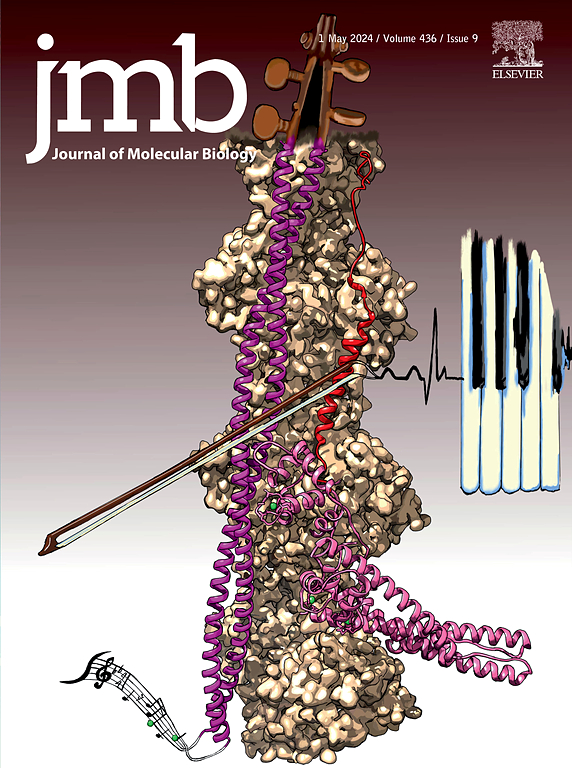Tau(350-362)是驱动调节氢甲基硫氨酸抑制纤维形成的关键区域。
IF 4.5
2区 生物学
Q1 BIOCHEMISTRY & MOLECULAR BIOLOGY
引用次数: 0
摘要
Tau297-391 (dGAE)在体外形成成对的螺旋细丝,类似于沉积在阿尔茨海默病脑组织中的细丝。我们之前已经证明氢甲基硫氨酸(HMT)能够以亚化学计量比抑制dGAE的自组装。在这里,我们研究了核心细丝形成区域内与自组装倾向相关的两个tau区域,并探索了它们形成细丝的能力以及它们的自组装是否可以被HMT抑制。我们证实,tau306-323可以自组装形成细丝,但HMT不抑制纤维形成。其他人先前的工作表明,tau350-362 (PAM4)形成的组装重现成对螺旋细丝的c形结构。在这里,手性光谱圆二色指纹图谱显示HMT与tau350-362结合,我们发现HMT抑制组装。我们得出结论,对组装和抑制重要的区域是由tau内部的c形区域形成的,并表明参与丝组装的中心区域可能与HMT相关,以防止自组装。本文章由计算机程序翻译,如有差异,请以英文原文为准。

A key region of Tau that is able to drive assembly and modulate inhibition by Hydromethylthionine
Tau297–391 (dGAE) forms paired helical filaments in vitro that resemble those deposited in Alzheimer’s disease brain tissue. We have previously shown that hydromethylthionine (HMT) has the ability to inhibit dGAE self-assembly at sub-stoichiometric ratios. Here, we examined two regions of tau within the core filament-forming region that possess high self-assembly propensity sequences and have explored their ability to form filaments and whether their self-assembly can be inhibited by HMT. We confirm that tau306–323 self-assembles to form filaments but that fibrillogenesis is not inhibited by HMT. Previous work by others has shown that tau350–362 (PAM4) forms assemblies that recapitulate the C-shaped structure of paired helical filaments. Here, a chiral spectral circular dichroism fingerprint shows that HMT binds to tau350–362 and we reveal that HMT inhibits assembly. We conclude that the region important for assembly and inhibition is formed by the inner C-shaped region of tau and suggest that the central region involved in filament assembly may associate with HMT to prevent self-assembly.
求助全文
通过发布文献求助,成功后即可免费获取论文全文。
去求助
来源期刊

Journal of Molecular Biology
生物-生化与分子生物学
CiteScore
11.30
自引率
1.80%
发文量
412
审稿时长
28 days
期刊介绍:
Journal of Molecular Biology (JMB) provides high quality, comprehensive and broad coverage in all areas of molecular biology. The journal publishes original scientific research papers that provide mechanistic and functional insights and report a significant advance to the field. The journal encourages the submission of multidisciplinary studies that use complementary experimental and computational approaches to address challenging biological questions.
Research areas include but are not limited to: Biomolecular interactions, signaling networks, systems biology; Cell cycle, cell growth, cell differentiation; Cell death, autophagy; Cell signaling and regulation; Chemical biology; Computational biology, in combination with experimental studies; DNA replication, repair, and recombination; Development, regenerative biology, mechanistic and functional studies of stem cells; Epigenetics, chromatin structure and function; Gene expression; Membrane processes, cell surface proteins and cell-cell interactions; Methodological advances, both experimental and theoretical, including databases; Microbiology, virology, and interactions with the host or environment; Microbiota mechanistic and functional studies; Nuclear organization; Post-translational modifications, proteomics; Processing and function of biologically important macromolecules and complexes; Molecular basis of disease; RNA processing, structure and functions of non-coding RNAs, transcription; Sorting, spatiotemporal organization, trafficking; Structural biology; Synthetic biology; Translation, protein folding, chaperones, protein degradation and quality control.
 求助内容:
求助内容: 应助结果提醒方式:
应助结果提醒方式:


